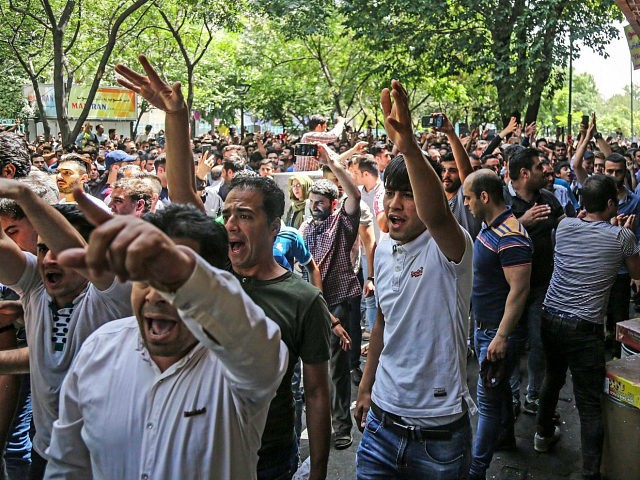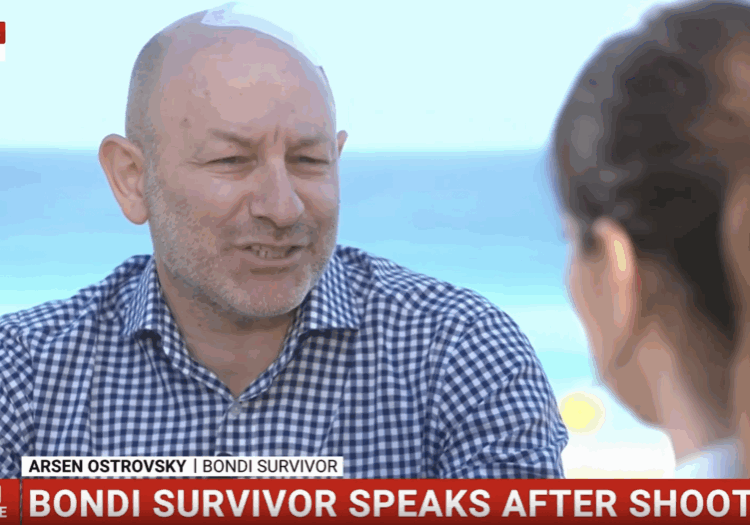FRESH AIR
Iranians declare ‘Palestine and Syria are making us miserable!’
July 5, 2018 | AIJAC staff

The Iranian people have taken to the streets several times over the past few years. Suffering under a repressive and oppressive regime led by religious hardliners, the public is crying for freedom. This is especially true with regards to the younger generation, who were not part of the 1979 Islamic revolution in which the previous dictator, the Shah, was toppled, only to be replaced by the oppressive regime of the mullahs.
Nowadays anger is mostly fuelled by the Government’s years-long failure to salvage the crippled economy.
The Government in Teheran has been unable to reverse the increasingly devastating effects of the international sanctions imposed on Iran due to its engagement in terror and its illegal undeclared nuclear program, aimed at producing an atomic bomb. While the 2015 Joint Comprehensive Plan of Action (JCPOA) nuclear agreement gave Iran access to $US100 billion or more, the regime has spent much of it on adventures abroad and strengthening the military – and has largely failed to use it to improve social welfare.
US President Donald Trump’s decision to pull out of the 2015 agreement with Iran in May has only escalated the deterioration of any already precarious internal financial situation in Iran. The withdrawal from the deal, which started a process that will see more and more biting economic sanctions against Iran over the next few months, is just one element of a new strong policy of applying intense economic and diplomatic pressure on Teheran via various channels. It is clear that even before new sanctions have come into effect, the anticipation of US sanctions and generally tougher policy is sending waves across the global economy, leading to dozens of international companies to cancel their dealings with Iran.
The widening protest
Protests against the regime have intensified since late 2017. In that context, there have been two noteworthy developments recently. The first is the growing number of sectors participating in these demonstrations – evidence that protestors are losing their psychological fear of the regime and its coercive powers.
The emerging effect of the coordinated pressure from the US is a further sharp decline of the Iranian economy, with immediate negative implications for the lives of ordinary Iranian citizens.
Iranians are crying out against the rising costs of food and other essentials and the disappearance of both their pensions and life savings through inflation. Purchasing imported items has become almost impossible, with the local currency, the Rial, reaching unprecedentedly low values (90,000 Rial for 1 USD in the black market).
In a last-minute attempt to counter the severe impact of the upcoming US sanctions prohibiting the export to Iran of a very wide range of products – due to begin in August and escalate in November – the regime is banning imports of 1,300 different goods into Iran. It is also planning to open a secondary foreign exchange market to try to stop the devaluation of the Rial and enable exporters of non-oil commodities to sell foreign currency earnings to importers of consumer products. But so far, all measures taken are unable to slow down the economy’s downward spiral.
Since late last year, strikes and protests across Iran have become common,. Different sectors of the population are increasingly taking part in the demonstrations. For example, ethnic minorities (Baluch, Azerbaijanis, Kurdish) most of whom reside in peripheral areas, have in recent months been joined by workers in major industries, such as steel and transport (truck drivers, taxis), and by professionals (teachers). A chronic water shortage, driven by both natural drought and water mismanagement, has brought farmers and citizens in southwestern Iran to the forefront of the protest over the last few days. Furthermore, social and political issues, most notably women’s rights (the hijab protest) still fuel occasional unrest as well.
The addition of the bazaar (market) merchants sector across the state to the anti-government protest movement marks another shift. Many of the traders (especially in Teheran) are considered conservatives with close ties to the ruling elite. However, growing impediments to trading in foreign goods, with rising customs tariffs and border closures, have made their economic situation much more difficult.
Demonstrations were recorded among bazaar merchants as early as April, mostly in cities along the rastern border with Iraq. At the end of June, rage which started over the inability to purchase cell phones, led angry clients and merchants at Teheran’s Grand Bazaar to call a general strike and organise protest marches through the streets of Iran’s capital. Chanting slogans against the regime, they were only stopped by police forces near the Majlis (the parliament). The historic and symbolic importance of the Grand Bazaar emanates from the fact that this is the place “where revolutions start” in Iran, including the 1979 Islamic takeover of power.
Forget Syria, look at our wallets!”, “Death to Palestine”
The second development relates to the reasons for the protests. As well as the anti-regime, social and economic calls during demonstrations, there is a new and open rejection of the Ayatollahs’ narrative of the Islamic revolution as the solution to all problems. Specifically, Iranians are openly opposing the centrality of the notion of “exporting” the revolution, which involves investing enormous resources into destabilising other parts of the Middle East.
For quite some time, Iranians have been chanting slogans against the corruption of their leaders, including against the alleged reformist President Rouhani, as well against the supreme leader, Ayatollah Khamenei (“Death to the dictator”). Rejecting the accusations voiced by Iran’s leadership that Trump and “the Zionists” are responsible for their dire economic situation, protesters chant that “America is not our enemy”.
In recent weeks, after pledging allegiance to their country (“My life for Iran!”), they have been also yelling out “Forget Syria, look at our wallets!”, “Death to Palestine”, “Palestine and Syria are making us miserable”.
Why? Because regular citizens, experiencing enormous daily hardships, watch with disbelief as billions of dollars of their money is being wasted on ideologically motivated adventures and failed military campaigns outside Iran. They see the funding of terrorist organisations and Iran proxies in Gaza; Iranian “experts” and non-Iranians who are armed and paid by Iran in Syria, the Lebanese Hezbollah and the Houthi rebels in Yemen, to name just a few.
Teheran recently stepped up efforts to destabilise Gaza. Channelling food and financial aid to terrorists through its subsidiary organisation in the strip, the Palestinian Islamic Jihad, Iran is aiming at further extending its supporter base in Gaza. Iranian money was seminal in fuelling the “March of Return” riots along the border with Israel, as was acknowledged by the Palestinian Authority itself.
It is clear many Iranian citizens no longer share their regime’s enthusiasm for liberating Palestine. A relatively small crowd participated in this year’s ‘Al Quds’ (Jerusalem) Day demonstrations on 8 June and many of those who did attend were pre-arranged by the Government. This year’s Ramadan campaign to aid Palestinians in Gaza and Lebanon, funded mostly by private Iranian citizens, caused uproar. Donation boxes for the program across Iran have been vandalised or tossed in the trash.
Of course, despite the widening cracks in the façade maintained by the Islamic regime, caution is in order. In the past, the Ayatollahs were able to contain and manage internal dissent, often using brutal force. This may happen again. Considering possible future scenarios, toppling of the existing regime still seems an unlikely short-term prospect. Vitally missing in that context is a powerful internal force, such as the army, to side with the anti-government elements. The Iranian Revolutionary Guard, and other armed organisations in Iran, are at one with the regime and still control major and vital parts of the Iranian economy.
Tags: Iran, Middle East
RELATED ARTICLES

The Government’s actions still fall short: Joel Burnie on FDD Morning Brief






















